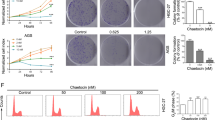Abstract
Both heme oxygenase-1 (HO-1) and p21WAF1/Cip1 (p21) are involved in the pathogenesis of human cancer and their functions are closely associated with apoptosis. However, how these two molecules regulate apoptosis in human gastric cancer is unknown. In this study, we studied how HO-1 and p21 were regulated in two gastric cancer cell lines, MKN-45 with wild p53 and MKN-28 with mutant p53. The cells were treated with hemin and cadmium to induce HO-1. The result showed that HO-1 protein was significantly induced by hemin and cadmium in both cells tested. Following the HO-1 expression, p21 level was also markedly induced. The cells with increased HO-1 and p21 showed obviously resistantance to apoptotic stimuli. The levels of HO-1 and p21 induced were significantly inhibited by p38 mitogen-activated protein kinase (p38 MAPK) inhibitor (SB203580) and extracellular-regulated kinase (ERK) inhibitor (PD098059). Parallel to decreased HO-1 and p21 expression, the kinase inhibitors also significantly attenuated the resistance of the cells to apoptosis. The elevated HO-1 and p21 was further found to be associated with increase activity of the nuclear NF-κB and the inhibition of NF-κB led to the block of their induction. The elevated HO-1 and p21 were also demonstrated to be related to increased cellular inhibitor of caspase inbitory protein-2 (c-IAP2) and decreased caspapse-3 activity. It was noted that the above changes observed were not different between MKN-45 and MKN-28 cells, suggesting the functions of HO-1 and p21 were irrespective of the status of p53. In conclusion, we demonstrate that the resistance to apoptosis in gastric cancer cells with elevated HO-1 and p21 is independent of p53 status in a p38 MAPK- and ERK-mediated pathway with elevated c-IAP2 and decreased caspase-3 activity and that this pathway is sensitive to the inhibition of NF-κB.
This is a preview of subscription content, access via your institution
Access options
Subscribe to this journal
Receive 50 print issues and online access
$259.00 per year
only $5.18 per issue
Buy this article
- Purchase on Springer Link
- Instant access to full article PDF
Prices may be subject to local taxes which are calculated during checkout






Similar content being viewed by others
Abbreviations
- CDK:
-
cyclin-dependent kinase
- c-IAP2:
-
cellular inhibitor of caspase inbitory protein-2
- ERK:
-
extracellular-regulated kinase
- FACS:
-
fluorescence-activated cell sorter analysis
- HO:
-
heme oxygenase
- MTT:
-
3-(4,5-dimethylthiazol-2-yl)-2,5-diphenyltetrazolium bromide) assay
- p21:
-
p21WAF1/Cip1
- p38 MAPK:
-
p38 mitogen-activated protein kinase
- PBS:
-
phosphate-buffered saline
- rhTNF-α:
-
recombinant human TNF-α
References
Baas IO, van Rees BP, Musler A, Craanen ME, Tytgat GN, van den Berg FM and Offerhaus GJ . (1998). J. Clin. Pathol., 51, 662–666.
Baldus SE, Schneider PM, Monig SP, Zirbes TK, Fromm S, Meyer W, Glossmann J, Schuler S, Thiele J, Holscher AH and Dienes HP . (2001). Scand. J. Gastroenterol., 36, 975–980.
Bortner CD and Cidlowski JA . (2002). Ann. Rev. Pharmacol. Toxicol., 42, 259–281.
Carter AB, Knudtson KL, Monick MM and Hunninghake GW . (1999). J. Biol. Chem., 274, 30858–30863.
Chandra J, Samali A and Orrenius S . (2000). Free Radical Biol. Med., 29, 323–333.
Chang BD, Watanabe K, Broude EV, Fang J, Poole JC, Kalinichenko TV and Roninson IB . (2000). Proc. Natl. Acad. Sci. USA, 97, 4291–4296.
Chellappan SP, Giordano A and Fisher PB . (1998). Curr. Top. Microbiol. Immunol., 227, 57–103.
Chen GG, Lee JF, Wang SH, Chan UP, Ip PC and Lau WY . (2002). Life Sci., 70, 2631–2646.
Chen K, Gunter K and Maines MD . (2000). J. Neurochem., 75, 304–313.
Chen K and Maines MD . (2000). Cell. Mol. Biol., 46, 609–617.
Craanen ME, Blok P, Offerhaus GJ, Meijer GA, Dekker W, Kuipers EJ and Meuwissen SG . (1999). J. Pathol., 189, 481–486.
Davis JN, Kucuk O, Djuric Z and Sarkar FH . (2001). Free Radical Biol. Med., 30, 1293–1302.
Elbirt KK, Whitmarsh AJ, Davis RJ and Bonkovsky HL . (1998). J. Biol. Chem., 273, 8922–8931.
Elledge RM, Clark GM, Fuqua SA, Yu YY and Allred DC . (1994). Cancer Res., 54, 3752–3757.
Erhardt P, Schremser EJ and Cooper GM . (1999). Mol. Cell. Biol., 19, 5308–5315.
Ferris CD, Jaffrey SR, Sawa A, Takahashi M, Brady SD, Barrow RK, Tysoe SA, Wolosker H, Baranano DE, Dore S, Poss KD and Snyder SH . (1999). Nat. Cell Biol., 1, 152–157.
Gilmore TD . (1999). Oncogene, 18, 6842–6844.
Goodman AI, Choudhury M, da Silva JL, Schwartzman ML and Abraham NG . (1997). Proc. Soc. Exp. Biol. Med., 214, 54–61.
Helt CE, Rancourt RC, Staversky RJ and O'Reilly MA . (2001). Toxicol. Sci., 63, 214–222.
Hiromura K, Pippin JW, Fero ML, Roberts JM and Shankland SJ . (1999). J. Clin. Invest., 103, 597–604.
Inguaggiato P, Gonzalez-Michaca L, Croatt AJ, Haggard JJ, Alam J and Nath KA . (2001). Kidney Int., 60, 2181–2191.
Jobin C, Panja A, Hellerbrand C, Iimuro Y, Didonato J, Brenner DA and Sartor RB . (1998). J. Immunol., 160, 410–418.
Liu XM, Chapman GB, Peyton KJ, Schafer AI and Durante W . (2002). Cardiovasc. Res., 55, 396–405.
Maines MD . (1988). FASEB J., 2, 2557–2568.
Maines MD and Abrahamsson PA . (1996). Urology, 47, 727–733.
Maines MD, Raju VS and Panahian N . (1999). J. Pharmacol. Exp. Ther., 291, 911–919.
McCoubrey Jr WK, Huang TJ and Maines MD . (1997). Eur. J. Biochem., 247, 725–732.
Murphy BJ, Laderoute KR, Vreman HJ, Grant TD, Gill NS, Stevenson DK and Sutherland RM . (1993). Cancer Res., 53, 2700–2703.
Okabe S, Ochiai Y, Aida M, Park K, Kim SJ, Nomura T, Suganuma M and Fujiki H . (1999). Jpn. J. Cancer Res., 90, 733–739.
Petrache I, Otterbein LE, Alam J, Wiegand GW and Choi AM . (2000). Am. J. Physiol. – Lung Cell. Mol. Physiol., 278, L312–L319.
Sasaki N, Morisaki T, Hashizume K, Yao T, Tsuneyoshi M, Noshiro H, Nakamura K, Yamanaka T, Uchiyama A, Tanaka M and Katano M . (2001). Clin. Cancer Res., 7, 4136–4142.
Suzuki A, Ito T, Kawano H, Hayashida M, Hayasaki Y, Tsutomi Y, Akahane K, Nakano T, Miura M and Shiraki K . (2000). Oncogene, 19, 1346–1353.
Suzuki A, Tsutomi Y, Akahane K, Araki T and Miura M . (1998). Oncogene, 17, 931–939.
Takahashi S, Mikami T, Watanabe Y, Okazaki M, Okazaki Y, Okazaki A, Sato T, Asaishi K, Hirata K, Narimatsu E, Mori M, Sato N and Kikuchi K . (1994). Am. J. Clin. Pathol., 101, 519–525.
Tuyt LM, Dokter WH, Birkenkamp K, Koopmans SB, Lummen C, Kruijer W and Vellenga E . (1999). J. Immunol., 162, 4893–4902.
Wakana Y, Kasuya K, Katayanagi S, Tsuchida A, Aoki T, Koyanagi Y, Ishii H and Ebihara Y . (2002). Oncol. Rep., 9, 1213–1218.
Waldman T, Kinzler KW and Vogelstein B . (1995). Cancer Res., 55, 5187–5190.
Wu J, Xia HH, Tu SP, Fan DM, Lin MC, Kung HF, Lam SK and Wong BC . (2003). Carcinogenesis, 24, 243–247.
Xu SQ and El-Deiry WS . (2000). Biochem. Biophys. Res. Commun., 269, 179–190.
Xu Y, Bialik S, Jones BE, Iimuro Y, Kitsis RN, Srinivasan A, Brenner DA and Czaja MJ . (1998). Am. J. Physiol., 275, C1058–C1066.
Yokozaki H . (2000). Pathol. Int., 50, 767–777.
Zechner D, Craig R, Hanford DS, McDonough PM, Sabbadini RA and Glembotski CC . (1998). J. Biol. Chem., 273, 8232–8239.
Zhang X, Shan P, Otterbein LE, Alam J, Flavell RA, Davis RJ, Choi AM and Lee PJ . (2003). J. Biol. Chem., 278, 1248–1258.
Acknowledgements
We thank Billy CS Leung and Suk Ying Chan for their technical help, David Brenner and Carrie Purbeck for DNA constructs used in this study.
Author information
Authors and Affiliations
Corresponding author
Rights and permissions
About this article
Cite this article
Liu, ZM., Chen, G., Ng, E. et al. Upregulation of heme oxygenase-1 and p21 confers resistance to apoptosis in human gastric cancer cells. Oncogene 23, 503–513 (2004). https://doi.org/10.1038/sj.onc.1207173
Received:
Revised:
Accepted:
Published:
Issue Date:
DOI: https://doi.org/10.1038/sj.onc.1207173
Keywords
This article is cited by
-
The dual role and mutual dependence of heme/HO-1/Bach1 axis in the carcinogenic and anti-carcinogenic intersection
Journal of Cancer Research and Clinical Oncology (2023)
-
Network analysis reveals that the tumor suppressor lncRNA GAS5 acts as a double-edged sword in response to DNA damage in gastric cancer
Scientific Reports (2022)
-
WD-40 repeat protein 26 protects against oxidative stress-induced injury in astrocytes via Nrf2/HO-1 pathways
Molecular Biology Reports (2022)
-
Effects of maternal exposure to arsenic on social behavior and related gene expression in F2 male mice
Environmental Health and Preventive Medicine (2021)
-
Non-competitive heme oxygenase-1 activity inhibitor reduces non-small cell lung cancer glutathione content and regulates cell proliferation
Molecular Biology Reports (2020)



